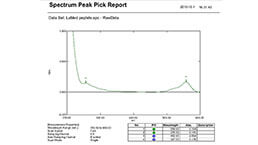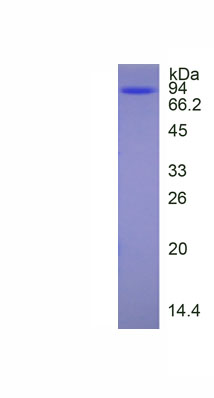Eukaryotic Fibronectin (FN) 

FN1; CIG; FINC; LETS; MSF; GFND2; Anastellin; Migration-Stimulating Factor; Cold-Insoluble Globulin; Large, External, Transformation-Sensitive Protein
Overview
Properties
- Product No.EPA037Hu61
- Organism SpeciesHomo sapiens (Human) Same name, Different species.
-
Applications
Positive Control; Immunogen; SDS-PAGE; WB.
If bio-activity of the protein is needed, please check active protein.
Research use only - DownloadInstruction Manual
- CategorySignal transductionInfection immunity
- Source Eukaryotic expression, Host 293F cell
- Endotoxin Level<1.0EU per 1µg (determined by the LAL method)
- Subcellular LocationSecreted, Extracellular matrix
- Molecular Mass 73.4kDa, Accurate 90kDa(Analysis of differences refer to the manual)
- Residues & TagsSer607~Pro1265 with N-terminal His Tag
- Buffer Formulation20mM Tris, 150mM NaCl, pH8.0, containing 1mM EDTA, 1mM DTT, 0.01% SKL, 5% Trehalose and Proclin300.
- Traits Freeze-dried powder, Purity > 95%
- Isoelectric Point4.5
Share your citation
Upload your experimental result
Review
Leave a message
Loading...
Sign into your account
Share a new citation as an author
Upload your experimental result
Review
Please attach serial No. on instruction manual


Contact us
Please fill in the blank.
Name*
Organization
Address
E-mail address*
Telephone
Inquiry*
Verification code*

Sequence

Usage
Reconstitute in 20mM Tris, 150mM NaCl (pH8.0) to a concentration of 0.1-1.0 mg/mL. Do not vortex.
Storage
Avoid repeated freeze/thaw cycles. Store at 2-8°C for one month. Aliquot and store at -80°C for 12 months.
Stability
The thermal stability is described by the loss rate. The loss rate was determined by accelerated thermal degradation test, that is, incubate the protein at 37°C for 48h, and no obvious degradation and precipitation were observed. The loss rate is less than 5% within the expiration date under appropriate storage condition.
Increment services
-
 BCA Protein Quantification Kit
BCA Protein Quantification Kit
-
 Protein Labeling Customized Service
Protein Labeling Customized Service
-
 Molecular Mass Marker for Protein
Molecular Mass Marker for Protein
-
 Monoclonal Antibody Customized Service
Monoclonal Antibody Customized Service
-
 Polyclonal Antibody Customized Service
Polyclonal Antibody Customized Service
-
 Protein Activity Test Experiment Service
Protein Activity Test Experiment Service
-
 Immunoprecipitation (IP) Experiment Service
Immunoprecipitation (IP) Experiment Service
-
 Electrophoretic Mobility Shift Assay (EMSA) Experiment Service
Electrophoretic Mobility Shift Assay (EMSA) Experiment Service
-
 Buffer
Buffer
-
 Lentivirus Packaging Experiment Service
Lentivirus Packaging Experiment Service
-
 Adenovirus Packaging Experiment Service
Adenovirus Packaging Experiment Service
-
 Real Time PCR Experimental Service
Real Time PCR Experimental Service
-
 Spike RBD Protein (S-RBD)
Spike RBD Protein (S-RBD)
-
 Protein G
Protein G
-
 Protein A
Protein A
Citations
- Advanced oxidation protein products induce mesangial cell perturbation through PKC-dependent activation of NADPH oxidasePubMed: 19019916
- Protein synthesis and secretion in human mesenchymal cells derived from bone marrow, adipose tissue and Wharton's jellyPubmed: 24739658
- Identification of compounds from the water soluble extract of Cinnamomum cassia barks and their inhibitory effects against high-glucose-induced mesangial cells.Pubmed: 24013407
- Bioactive compounds from Cornus officinalis fruits and their effects on diabetic nephropathyScienceDirect: S0378874114002414
- Inhibition by Female Sex Hormones of Collagen Gel Contraction Mediated by Retinal Pigment Epithelial CellsPubmed: 24609629
- Mesenchymal stromal cell proliferation, gene expression and protein production in human platelet-rich plasma-supplemented mediaPubmed:Pmc4130592
- Metabolic and cytoprotective effects of in vivo peri-patellar hyaluronic acid injections in cultured tenocytesPubmed:25333747
- Establishing principles of macromolecular crowding for in vitro fibrosis research of the vocal fold lamina propriaPubmed:25545625
- In vivo bioengineered ovarian tumors based on collagen, matrigel, alginate and agarose hydrogels: a comparative studyPubmed:25634132
- In vivoPubMed: 25634132
- Impact of Nigella Sativa, Omega-3 Fatty Acids and Chromium Picolinate onNF-κB/leptin-insulin Axisin Obese Subjects with Non-alcoholic Fatty Liver DiseaseAjmbr: 3
- Comparative proteomics of milk fat globule membrane in goat colostrum and mature milkPubmed:27173528
- Maternal endothelial damage as a disorder shared by early preeclampsia, late preeclampsia and intrauterine growth restriction.pubmed:27865093
- Effect of panax notoginseng saponins on efficacy and hemorrhagic transformation of rt-PA intravenous thrombolysis in patients with acute ischemic strokeArticle_en:CJFDTotal-XDJB201611014
- Serum fbronectin distinguishes the early stages of hepatocellular carcinomapubmed:28842594
- Pigment epithelium‑derived factor protects human glomerular mesangial cells from diabetes via NOXO1‑iNOS suppression10.3892/mmr.2017.7563
- Tenomodulin is essential for prevention of adipocyte accumulation and fibrovascular scar formation during early tendon healing.pubmed:29022912
- Effects of panax notoginseng saponin on the pathological ultrastructure and serum IL‐6 and IL‐8 in pulmonary fibrosis in rabbitsPubmed:29932250
- Corn silk (Zea mays L.), a source of natural antioxidants with α-amylase, α-glucosidase, advanced glycation and diabetic nephropathy inhibitory activitiesPubmed: 30530231
- Impact of Hydrogel Elasticity and Adherence on Osteosarcoma Cells and OsteoblastsPubmed: 30838809
- TNF-α Regulates ITGβ1 and SYND4 Expression in Nucleus Pulposus Cells: Activation of FAK/PI3K SignalingPubmed: 31111299
- Three kinds of corneal host cells contribute differently to corneal neovascularization
- Effects of autophagy on macrophage adhesion and migration in diabetic nephropathyPubmed: 31352855
- Growth hormone induces Notch1 signaling in podocytes and contributes to proteinuria in diabetic nephropathyPubmed: 31511328
- Fabrication and Evaluation of a Xenogeneic Decellularized Nerve-Derived Material: Preclinical Studies of a New Strategy for Nerve RepairPubmed: 31758411
- Molecular hydrogen regulates PTEN‐AKT‐mTOR signaling via ROS to alleviate peritoneal dialysis‐related peritoneal fibrosisPubmed: 31930571
- Damage-Associated Molecular Patterns and Th-Cell-Related Cytokines Released after Progressive EffortPubmed: 32210109
- Are the Circulating Levels of Copeptin and Fibronectin Dysregulated in Preeclamptic South African Black Women?
- Advanced glycation end-products associate with podocytopathy in type II diabetic patients
- Early mobilization in spinal cord injury promotes changes in microglial dynamics and recovery of motor functionPubmed:35586775







